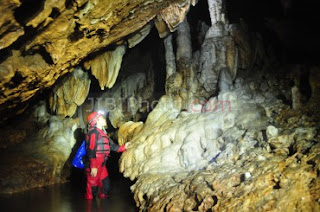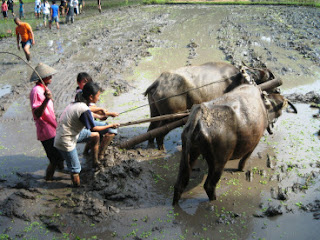 Parangtritis Beach
Parangtritis Beach is a coastal tourist area 28 km south of Yogyakarta, known also by the term South Beach. In this area there are also Parangkusumo Beach, known as the beaches for a "labuhan", or spiritual activities Kraton Yogyakarta. And, Depok Beach, renowned as a culinary beaches, because there are many traditional restaurant with a seafood menu. Here you can buy fresh fish from the fishermen, or at the fish market available in this beaches area.
That said, according to local community, the name Parangtritis comes from Dipokusumo, a fugitive of Majapahit empire. In their meditation in the region, he saw water dripping (Tumaritis) from the crack rock (parang). Furthermore, he gave him the name Parangtritis, which means the water that drips off the rocks.
Region the beach has a large area, consisting of Parangendog region, Parangwedang, and Parangtritis itself. You do not have to worry for exploring this region, locals rent a horse, "bendi" or carriage horses, and ATVs motorcycles, at affordable prices. Unlike the
beaches in Bali, which can be used for swimming, surfing, and other beach tourism. Parangtritris Beach, you are forbidden to bathe and swim in the sea, because the waves are big, and the ocean trenches that can drag you into the sea. However, you do not need to worry, because the the Coast Guard is always drive around to remind tourists, and maintain the safety of tourists.
Besides beach area, that special from Parangtritis Beach area, is "gumuk pasir" or sand dunes. This "gumuk pasir" is a rare natural phenomenon in the world. You can climb these dunes, and looking towards the sea with stunning scenery. If you want to know the occurrence of the sand dunes, you can visit the
Geospatial Laboratory is approximately 1.5 km from Parangtritis Beach.
The main building as ladmark Geospatial Laboratory, pyramid architecture. In another building holds a collection of various kinds of equipment mapping and geography, various sand beaches and rocks. To get to the pyramid-shaped building, connected by a corridor called the hall of knowledge. In the hallway there is information that describes the process of "gumuk pasir” or sand dunes in Parangtritis.
Written by: Jogja Holidays
Jogja Holidays, Updated at:
11:40 PM






















